非谓语动词的句法作用
- 格式:doc
- 大小:51.50 KB
- 文档页数:3
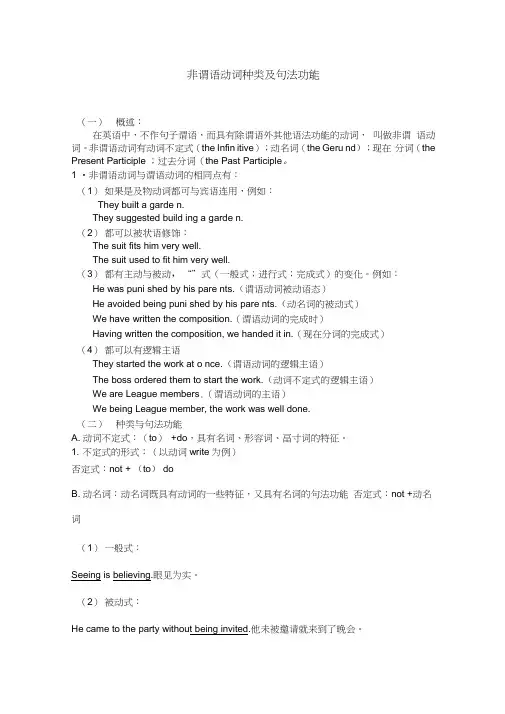
非谓语动词种类及句法功能(一)概述:在英语中,不作句子谓语,而具有除谓语外其他语法功能的动词,叫做非谓语动词。
非谓语动词有动词不定式(the Infin itive);动名词(the Geru nd);现在分词(the Present Participle ;过去分词(the Past Participle。
1 •非谓语动词与谓语动词的相同点有:(1)如果是及物动词都可与宾语连用,例如:They built a garde n.They suggested build ing a garde n.(2)都可以被状语修饰:The suit fits him very well.The suit used to fit him very well.(3)都有主动与被动,“”式(一般式;进行式;完成式)的变化。
例如:He was puni shed by his pare nts.(谓语动词被动语态)He avoided being puni shed by his pare nts.(动名词的被动式)We have written the composition.(谓语动词的完成时)Having written the composition, we handed it in.(现在分词的完成式)(4)都可以有逻辑主语They started the work at o nce.(谓语动词的逻辑主语)The boss ordered them to start the work.(动词不定式的逻辑主语)We are League members.(谓语动词的主语)We being League member, the work was well done.(二)种类与句法功能A. 动词不定式:(to)+do,具有名词、形容词、畐寸词的特征。
1. 不定式的形式:(以动词write为例)否定式:not + (to) doB. 动名词:动名词既具有动词的一些特征,又具有名词的句法功能否定式:not +动名词(1)一般式:Seeing is believing.眼见为实。
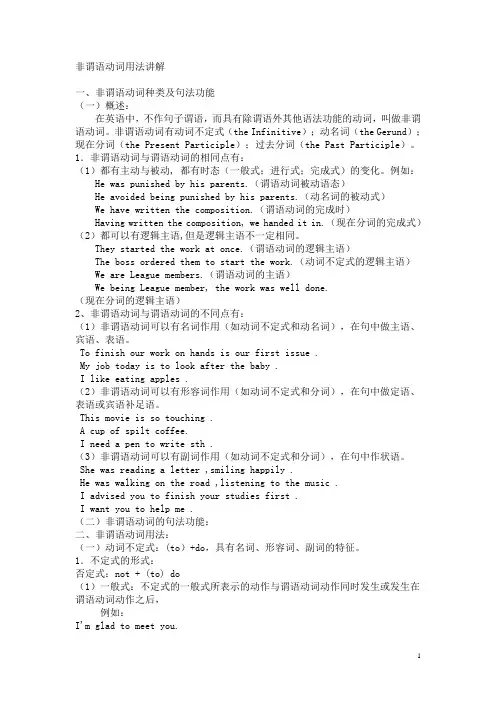
非谓语动词用法讲解一、非谓语动词种类及句法功能(一)概述:在英语中,不作句子谓语,而具有除谓语外其他语法功能的动词,叫做非谓语动词。
非谓语动词有动词不定式(the Infinitive);动名词(the Gerund);现在分词(the Present Participle);过去分词(the Past Participle)。
1.非谓语动词与谓语动词的相同点有:(1)都有主动与被动, 都有时态(一般式;进行式;完成式)的变化。
例如:He was punished by his parents.(谓语动词被动语态)He avoided being punished by his parents.(动名词的被动式)We have written the composition.(谓语动词的完成时)Having written the composition, we handed it in.(现在分词的完成式)(2)都可以有逻辑主语,但是逻辑主语不一定相同。
They started the work at once.(谓语动词的逻辑主语)The boss ordered them to start the work.(动词不定式的逻辑主语)We are League members.(谓语动词的主语)We being League member, the work was well done.(现在分词的逻辑主语)2、非谓语动词与谓语动词的不同点有:(1)非谓语动词可以有名词作用(如动词不定式和动名词),在句中做主语、宾语、表语。
To finish our work on hands is our first issue .My job today is to look after the baby .I like eating apples .(2)非谓语动词可以有形容词作用(如动词不定式和分词),在句中做定语、表语或宾语补足语。

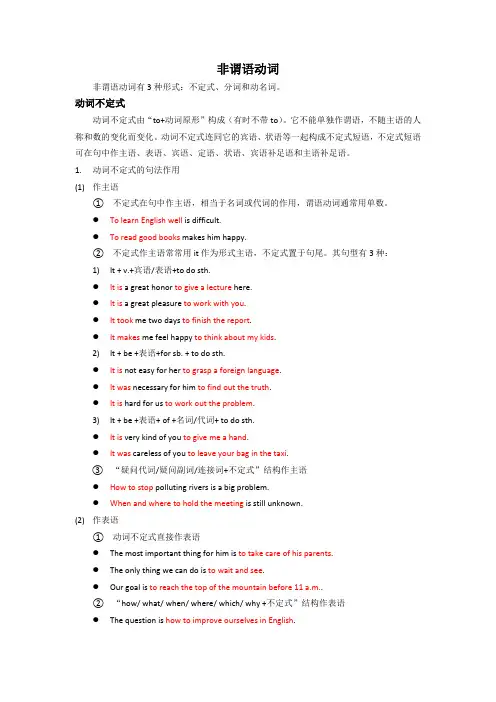
非谓语动词非谓语动词有3种形式:不定式、分词和动名词。
动词不定式动词不定式由“to+动词原形”构成(有时不带to)。
它不能单独作谓语,不随主语的人称和数的变化而变化。
动词不定式连同它的宾语、状语等一起构成不定式短语,不定式短语可在句中作主语、表语、宾语、定语、状语、宾语补足语和主语补足语。
1.动词不定式的句法作用(1)作主语① 不定式在句中作主语,相当于名词或代词的作用,谓语动词通常用单数。
●To learn English well is difficult.●To read good books makes him happy.② 不定式作主语常常用it作为形式主语,不定式置于句尾。
其句型有3种:1)It + v.+宾语/表语+to do sth.●It is a great honor to give a lecture here.●It is a great pleasure to work with you.●It took me two days to finish the report.●It makes me feel happy to think about my kids.2)It + be +表语+for sb. + to do sth.●It is not easy for her to grasp a foreign language.●It was necessary for him to find out the truth.●It is hard for us to work out the problem.3)It + be +表语+ of +名词/代词+ to do sth.●It is very kind of you to give me a hand.●It was careless of you to leave your bag in the taxi.③ “疑问代词/疑问副词/连接词+不定式”结构作主语●How to stop polluting rivers is a big problem.●When and where to hold the meeting is still unknown.(2)作表语① 动词不定式直接作表语●The most important thing for him is to take care of his parents.●The only thing we can do is to wait and see.●Our goal is to reach the top of the mountain before 11 a.m..② “how/ what/ when/ where/ which/ why +不定式”结构作表语●The question is how to improve ourselves in English.●The point is when to leave for Hong Kong.●The difficulty is which one to give the reward to.(3)作宾语① 动词不定式直接作及物动词的宾语常以动词不定式作宾语的动词由:afford, agree, ask, begin, choose, continue, decide, demand, expect, forget, hate, help, intend, learn, like, mean, need, offer, plan, prepare, prefer, pretend, promise, refuse, remember, require, start, try, volunteer, want, wish等。
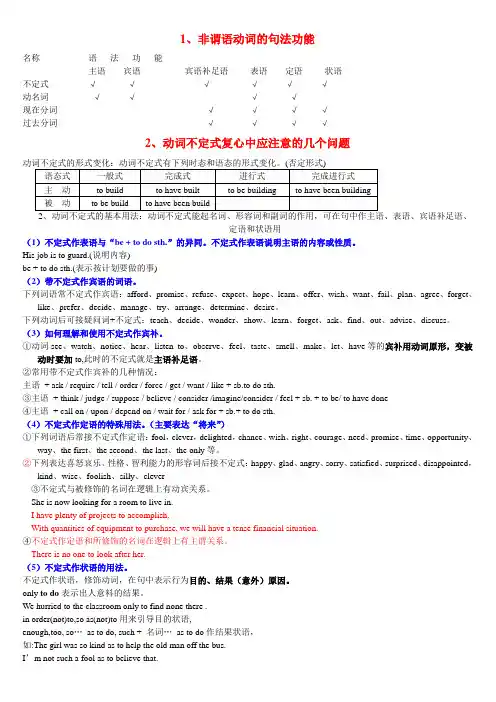
1、非谓语动词的句法功能名称语法功能主语宾语宾语补足语表语定语状语不定式√√√√√√动名词√√√√现在分词√√√√过去分词√√√√2、动词不定式复心中应注意的几个问题定语和状语用(1)不定式作表语与“be + to do sth.”的异同。
不定式作表语说明主语的内容或性质。
His job is to guard.(说明内容)be + to do sth.(表示按计划要做的事)(2)带不定式作宾语的词语。
下列词语常不定式作宾语:afford、promise、refuse、expect、hope、learn、offer、wish、want、fail、plan、agree、forget、like、prefer、decide、manage、try、arrange、determine、desire。
下列动词后可接疑问词+不定式:teach、decide、wonder、show、learn、forget、ask、find、out、advise、discuss。
(3)如何理解和使用不定式作宾补。
①动词see、watch、notice、hear、listen to、observe、feel、taste、smell、make、let、have等的宾补用动词原形,变被动时要加to,此时的不定式就是主语补足语。
②常用带不定式作宾补的几种情况:主语+ ask / require / tell / order / force / get / want / like + sb.to do sth.③主语+ think / judge / suppose / believe / consider /imagine/consider / feel + sb. + to be/ to have done④主语+ call on / upon / depend on / wait for / ask for + sb.+ to do sth.(4)不定式作定语的特殊用法。
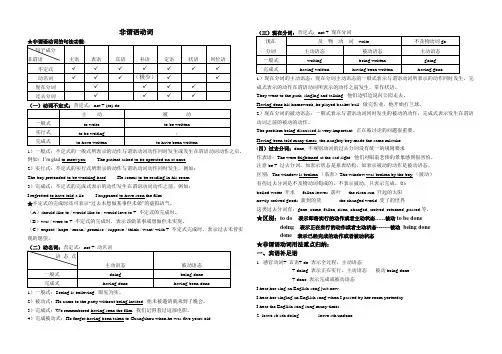
非谓语动词1)一般式:不定式的一般式所表示的动作与谓语动词动作同时发生或发生在谓语动词动作之后,例如:I’m glad to meet you. The patient asked to be operated on at once.2)实行式:不定式的实行式所表示的动作与谓语动词动作同时发生,例如:The boy pretended to be working hard. He seems to be reading in his room.3)完成式:不定式的完成式表示的动作发生在谓语动词动作之前,例如:I regretted to have told a lie. I happened to have seen the film.★不定式的完成时还可表示“过去本想做某事但未做”的虚拟语气。
(A)should like to / would like to / would love to + 不定式的完成时。
(B)was / were to + 不定式的完成时,表示该做某事或想做但未实现。
(C)expect / hope / mean / promise / suppose / think / want/ wish + 不定式完成时,表示过去未曾实现的愿望。
1)一般式:Seeing is believing. 眼见为实。
2)被动式:He came to the party without being invited. 他未被邀请就来到了晚会。
3)完成式:We remembered having seen the film. 我们记得看过这部电影。
4)完成被动式:He forgot having been taken to Guangzhou when he was five years old.1)现在分词的主动语态:现在分词主动语态的一般式表示与谓语动词所表示的动作同时发生,完成式表示的动作在谓语动词所表示的动作之前发生,常作状语。
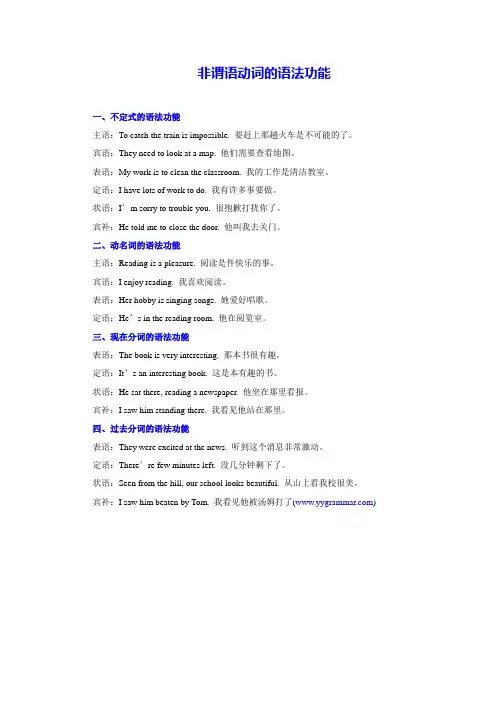
非谓语动词的语法功能一、不定式的语法功能主语:To catch the train is impossible. 要赶上那趟火车是不可能的了。
宾语:They need to look at a map. 他们需要查看地图。
表语:My work is to clean the classroom. 我的工作是清洁教室。
定语:I have lots of work to do. 我有许多事要做。
状语:I’m sorry to trouble you. 很抱歉打扰你了。
宾补:He told me to close the door. 他叫我去关门。
二、动名词的语法功能主语:Reading is a pleasure. 阅读是件快乐的事。
宾语:I enjoy reading. 我喜欢阅读。
表语:Her hobby is singing songs. 她爱好唱歌。
定语:He’s in the reading room. 他在阅览室。
三、现在分词的语法功能表语:The book is very interesting. 那本书很有趣。
定语:It’s an interesting book. 这是本有趣的书。
状语:He sat there, reading a newspaper. 他坐在那里看报。
宾补:I saw him standing there. 我看见他站在那里。
四、过去分词的语法功能表语:They were excited at the news. 听到这个消息非常激动。
定语:There’re few minutes left. 没几分钟剩下了。
状语:Seen from the hill, our school looks beautiful. 从山上看我校很美。
宾补:I saw him beaten by Tom. 我看见他被汤姆打了()谈谈分词的逻辑主语问题一、什么是分词的逻辑主语分词属非谓语动词,没有真正的主语。
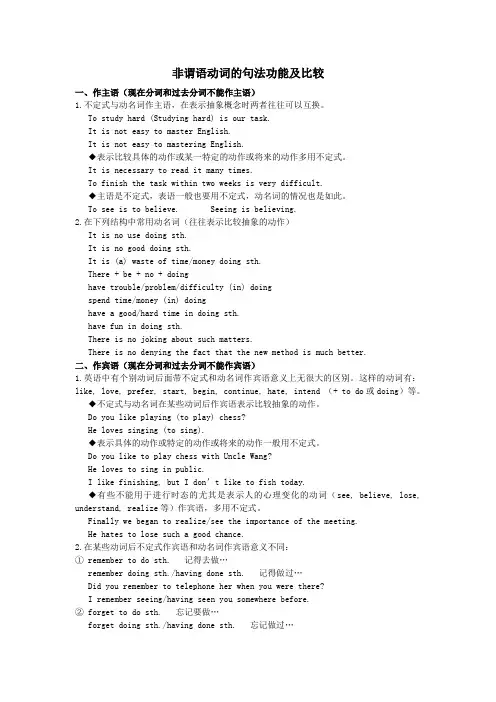
非谓语动词的句法功能及比较一、作主语(现在分词和过去分词不能作主语)1.不定式与动名词作主语,在表示抽象概念时两者往往可以互换。
To study hard (Studying hard) is our task.It is not easy to master English.It is not easy to mastering English.◆表示比较具体的动作或某一特定的动作或将来的动作多用不定式。
It is necessary to read it many times.To finish the task within two weeks is very difficult.◆主语是不定式,表语一般也要用不定式,动名词的情况也是如此。
To see is to believe. Seeing is believing.2.在下列结构中常用动名词(往往表示比较抽象的动作)It is no use doing sth.It is no good doing sth.It is (a) waste of time/money doing sth.There + be + no + doinghave trouble/problem/difficulty (in) doingspend time/money (in) doinghave a good/hard time in doing sth.have fun in doing sth.There is no joking about such matters.There is no denying the fact that the new method is much better.二、作宾语(现在分词和过去分词不能作宾语)1.英语中有个别动词后面带不定式和动名词作宾语意义上无很大的区别。
这样的动词有:like, love, prefer, start, begin, continue, hate, intend (+ to do或doing)等。

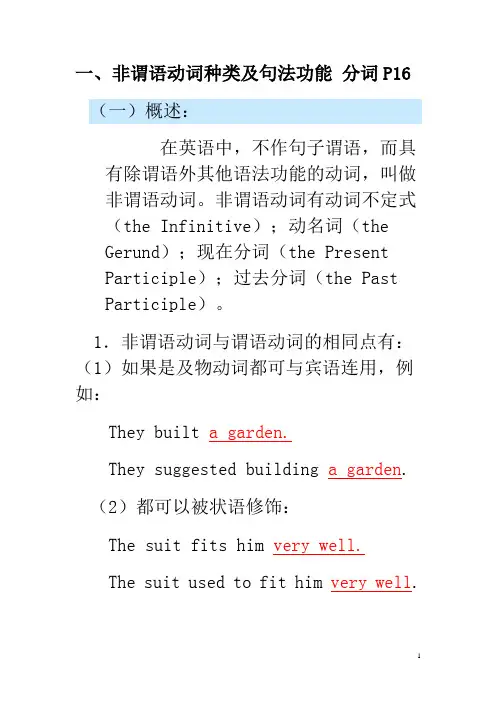
一、非谓语动词种类及句法功能分词P16(一)概述:在英语中,不作句子谓语,而具有除谓语外其他语法功能的动词,叫做非谓语动词。
非谓语动词有动词不定式(the Infinitive);动名词(theGerund);现在分词(the PresentParticiple);过去分词(the PastParticiple)。
1.非谓语动词与谓语动词的相同点有:(1)如果是及物动词都可与宾语连用,例如:They built a garden.They suggested building a garden.(2)都可以被状语修饰:The suit fits him very well.The suit used to fit him very well.(3)都有主动与被动, “体”式(一般式;进行式;完成式)的变化。
例如:He was punished by his parents.(谓语动词被动语态)He avoided being punished by his parents.(动名词的被动式)We have written the composition.(谓语动词的完成时)Having written the composition, we handed it in.(现在分词的完成式)(4)都可以有逻辑主语They started the work at once.(谓语动词的逻辑主语)The boss ordered them to start the work.(动词不定式的逻辑主语)We are League members.(谓语动词的主语)We being League member, the work was well done.(现在分词的逻辑主语)2、非谓语动词与谓语动词的不同点有:(1)非谓语动词可以有名词作用(如动词不定式和动名词),在句中做主语、宾语、表语。
(2)非谓语动词可以有形容词作用(如动词不定式和分词),在句中做定语、表语或宾语补足语。
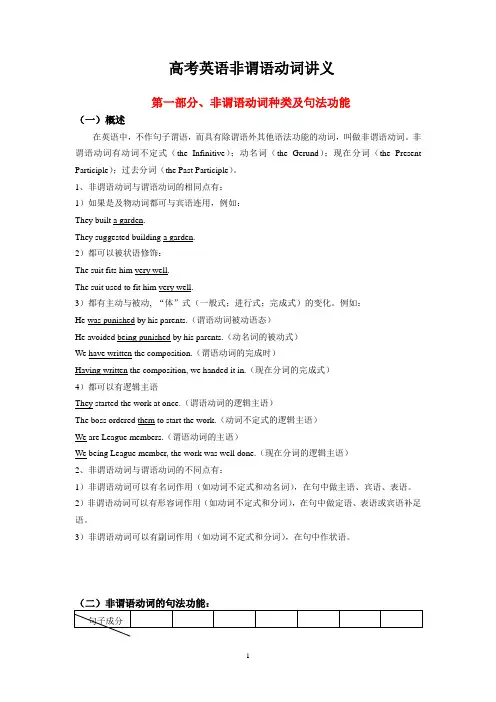
高考英语非谓语动词讲义第一部分、非谓语动词种类及句法功能(一)概述在英语中,不作句子谓语,而具有除谓语外其他语法功能的动词,叫做非谓语动词。
非谓语动词有动词不定式(the Infinitive);动名词(the Gerund);现在分词(the Present Participle);过去分词(the Past Participle)。
1、非谓语动词与谓语动词的相同点有:1)如果是及物动词都可与宾语连用,例如:They built a garden.They suggested building a garden.2)都可以被状语修饰:The suit fits him very well.The suit used to fit him very well.3)都有主动与被动, “体”式(一般式;进行式;完成式)的变化。
例如:He was punished by his parents.(谓语动词被动语态)He avoided being punished by his parents.(动名词的被动式)We have written the composition.(谓语动词的完成时)Having written the composition, we handed it in.(现在分词的完成式)4)都可以有逻辑主语They started the work at once.(谓语动词的逻辑主语)The boss ordered them to start the work.(动词不定式的逻辑主语)We are League members.(谓语动词的主语)We being League member, the work was well done.(现在分词的逻辑主语)2、非谓语动词与谓语动词的不同点有:1)非谓语动词可以有名词作用(如动词不定式和动名词),在句中做主语、宾语、表语。
2)非谓语动词可以有形容词作用(如动词不定式和分词),在句中做定语、表语或宾语补足语。
词法:非谓语动词用法区别非谓语动词共有三种形式:不定式、动词的-ing形式和动词的-ed形式。
现以动词make为例,将非谓语动词的三种形式及其功能总结如下。
(1)非谓语动词的不定式①主动语态②被动语态③句法功能:在句中可做主、宾、表、定、状A.一般式to make A.一般式to be made 补语。
B.进行时to be making B.完成式to have been madeC.完成式to have made(2)非谓语动词的-ing形式①主动语态②被动语态③句法功能:在句中可做主、宾、表、定、状A.一般式making A.一般式:being made 补语。
B.完成式having made B.完成式:having been made(3)非谓语动词的-ed形式①被动语态A.一般式madeB.完成式made②句法功能:在句中可做表、定、状、补语。
由以上可以看出,非谓语动词的各种形式在意义上有相交叉的区域,因此认真区分它们的用法对于准确理解和表达英语是很有帮助的。
如to be done , being done , done , having been done 都可表示被动,同时都可作定语,但它们在作定语时是有明显区别的。
The school to be built is intended for the disabled children .即将要建的学校是为了残疾儿童而设的。
The school being built is intended for the disabled children .正在建设的学校是为残疾儿童而设的。
The school built last year is intended for the disabled children .去年建的学校是为残疾儿童而设的。
The school , having been built for two years , is intended for the disabled children .花了两年多建设的学校是为残疾儿童而设的。
非谓语动词句法作用详解非谓语动词是指在主语之外的动词形式,它可以作主语、宾语、定语、状语等句法成分。
非谓语动词的使用丰富了句子的表达方式,增加了句子的灵活性和表达力。
本文将详细解析非谓语动词在句法结构中的各种作用。
一、作主语1. V-ing作主语现在分词(V-ing)作主语时,通常表示主动、进行或普遍性的动作。
例如:Swimming is my favorite sport.(游泳是我最喜爱的运动。
)Running in the morning is good for your health.(早晨跑步对健康有好处。
)2. To-infinitive作主语不定式(To-infinitive)作主语时,常用来表示意图、建议、可能性等。
例如:To learn a foreign language is challenging but rewarding.(学一门外语既具有挑战性又有回报。
)To visit the Grand Canyon is on my bucket list.(参观大峡谷是我计划表上的一项。
)二、作定语1. V-ing作定语现在分词(V-ing)作定语时,常用来修饰名词,表示被修饰名词的用途、功能、来源等。
例如:The running water is so refreshing.(流动的水非常清爽。
)A sleeping baby needs to be treated gently.(熟睡的婴儿需要温柔对待。
)2. 过去分词作定语过去分词作定语时,通常用来修饰被动或完成的状态、感受等。
例如:The broken window needs to be fixed.(这个破窗户需要修理。
)The lost key was found under the bed.(丢失的钥匙在床底下找到了。
)三、作宾语1. 不定式作宾语不定式(To-infinitive)作宾语时,常用来表示目的、打算、习惯等。
非谓语动词的用法在英语语法中,掌握好动词的用法是最重要的,而非谓语动词又是动词中非常重要的一部分,由于它们内容多,有些用法相似,所以不好掌握,经常被混淆用错,下面通过列表比较的方式,分析非谓语动词的主要用法。
非谓语动词和谓语动词的相对时间关系1. 非谓语动词被动语态的意义三.非谓语动词的句法作用2. 非谓语动词作主语过 去 分 词相当于形容词说 明主语动作的性 质或状态,一般 后面带介词短 语,有些形容词 化的过去分词前 可加 very.有时可用 become ; get ;remain ; appear ; seem; fell; go; look 等动词He remained puzzled. He appeared satisfied with that.My work is finished. My watch is gone. 常见的过去分词有: 1) 常见带介词 about 分词:annoyed, concerned, excited, pleased, puzzled, shocked, worried 2) 常见带介词 at分词: amazed, amused, annoyed, astonished,delighted, disappointed, disgusted,displeased, dissatisfied, excited, offended, overjoyed, pleased, shocked, surprised, 3) 常见带介词 against 分词: arranged, prepared, irritated, arranged 4)常见带介词 for 分词: celebrated,concerned, destined, disqualified, noted, prepared, pressed, qualified. 5) 常见带介词 in 分词: absorbed, celebrated,concerned, disappointed, delighted, dressed, embarrassed, engaged, entangled, experienced, interested lost, 6) 常见带介词 on 分词: founded, based, bent, set 7) 常见带介词 to 分词: abandoned,accustomed, acquainted, addicted, adapted, committed, dedicated, destined, devoted, doomed, engaged, entitled, exposed, known, lost, opposed, related, inclined, married 8) 常见带介词 with 分词: annoyed, bored, concerned, delighted, disappointed, discontented, disgusted, displeased, dissatisfied, equipped, excited, occupied, obsessed, pleased, pressed, satisfied, socked, stunned, surrounded loaded,tormented, torture6.7.8.四. 非谓语动词的特殊形式五. 非谓语动词的否定形式英语中将来时的表示形式表示将要发生的动作和状态在英语中用将来时,将来时在英语中有多种表达形式,为了掌握它们的区别和用法,下面笔者对它们进行分类总结。